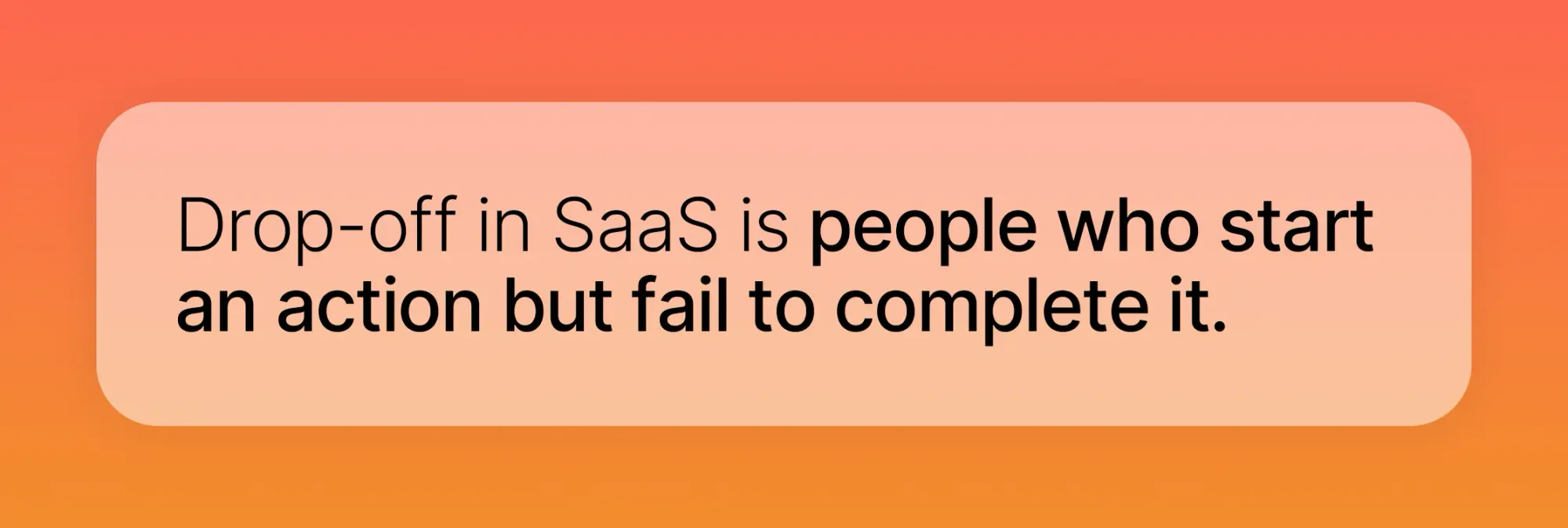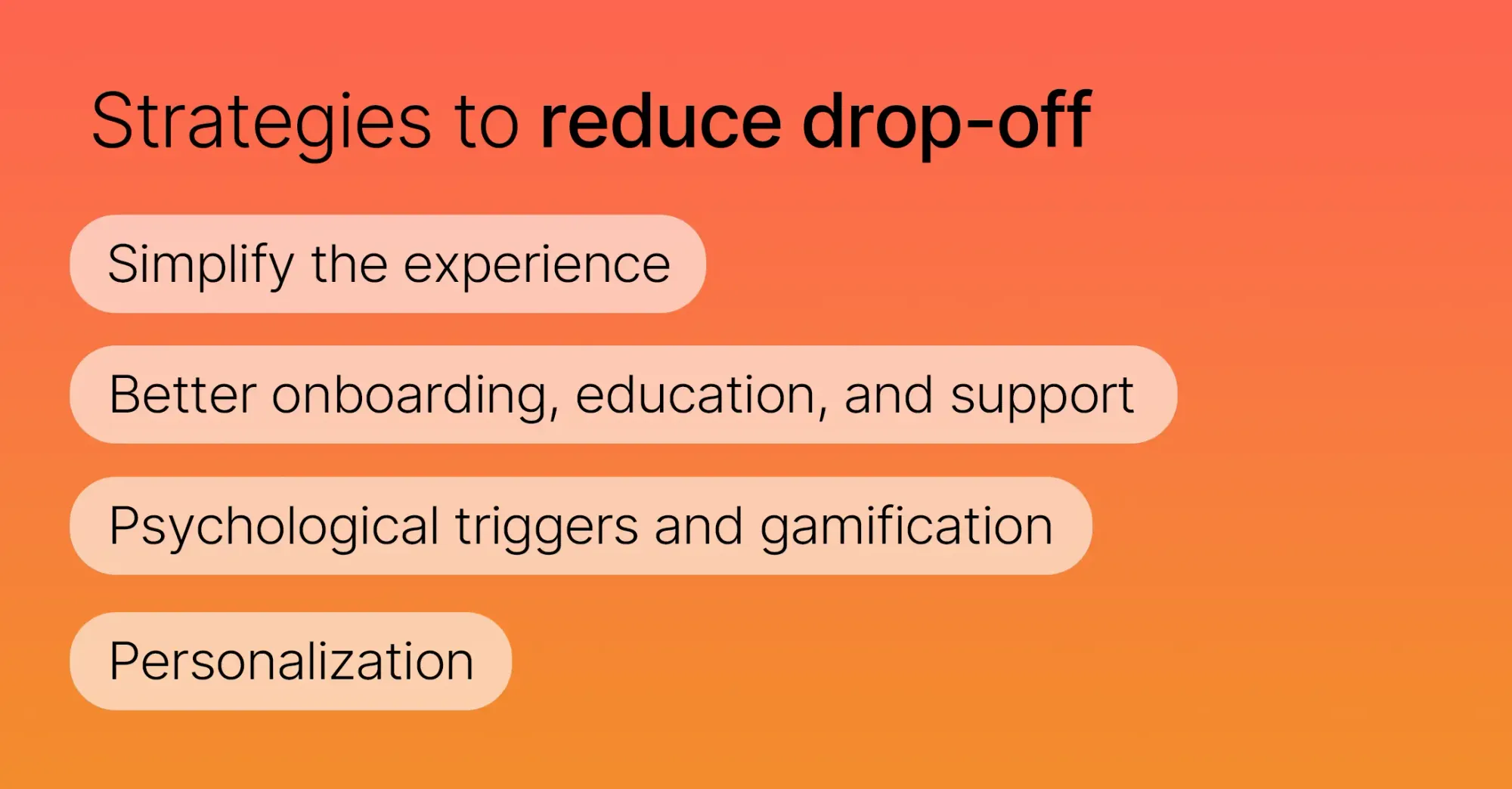Keep your users clicking and reduce your drop-off rate
Drop-off rate is one of the most actionable engagement metrics in SaaS, because it gives you a concrete idea of where the experience is falling flat.

Everyone loves window shopping. You get the satisfaction of picking up a shiny new thing, imagining your life with it in it, but you don’t have to actually cough up the money. Of course, this satisfaction is shallow and short-lived and you won’t actually reap the full benefits of whatever it is you’re looking at.
Now consider yourself as the store owner. You get your hopes up seeing someone’s eyes light up holding your products. You’re so sure that they’ll soon make their way to the cash register and then…
They leave. Brutal.
This same thing happens all the time in SaaS products, too, and we call it drop-off. High drop-off rates are a clear indicator of unfulfilled potential, so we want to reduce them as much as possible.
Understanding drop-off rate
Drop-off rate is a common metric across several industries, typically referring to the people who start the process of purchasing a product or service but then abandon it.
In the SaaS context, drop-off rate can expand further than just the purchase stage. It indicates the percentage of users who begin an action or process within the application but fail to complete it. People could “drop” from a variety of actions, like sign-up, free trial conversions, onboarding, feature adoption, and subscription renewal processes.

This metric is essential for understanding user engagement and identifying points within the user journey where interest dissipates or obstacles pop up.
Your drop-off rate is a good indicator of the effectiveness of various features and workflows in your product. High rates may signal areas where your user experience is less intuitive or where you may be falling short of user expectations. A high drop-off rate typically signals problems with conversions and retention, meaning it has a relatively direct line to your revenue.
For example, if a significant number of users start the onboarding process but don’t see it through to the end, there might be issues with the clarity of the instructions, the number of steps needed to take, or their perceived value in the product at that stage. The onboarding experience you’re currently offering may be sabotaging the relationship with new users.
When calculated, analyzed, and acted on effectively, drop-off rate can make up part of a strong foundation to boost user engagement and satisfaction.
How to measure drop-off rate
The actual formula for calculating drop-off rate is very simple. You divide the total number of users who completed the action by the total number of people who started the action. Subtract that number from 1 and Multiply it by 100% and you have your drop-off rate.
So for example, let’s say 500 people started the process of creating a custom report on your platform. Of those 500 people, only 300 take all of the steps necessary to complete the report. You would have a drop-off rate of 40%.
(1 - (300/500) = 0.4 → 0.4x100% = 40%)

Using funnel analysis, you can identify specific stages in the process that have higher drop-off rates, which can help pinpoint areas for improvement in the user experience or interface. For instance, if you see a significant number of users drop off at the data selection stage, this might indicate that you need to dig deeper into the root of the problem. Maybe the data input process is too complicated or poorly designed.
To calculate your drop-off rate, you need analytics tools that can accurately track in-app events or page views. Some popular tools include Google Analytics, Mixpanel, Heap, and Adobe Analytics.
And after you measure it…?
Measurement is just the first step in leveraging your drop-off rate to create a better, more engaging product. You need to continuously monitor user behavior, analyze the drop-off rate, and use the insights you pull out to improve the customer experience. (And hopefully, increase your volume of new customers and renewals).
Path analysis
If your funnel analysis points to a specific problem area, a path analysis can help you take a more granular look and helps you understand the sequences of actions that lead up to a drop-off, which can be particularly useful for identifying unexpected user behavior that may be causing unanticipated friction.
Understanding the route that users take to complete a task can help you optimize, simplify, or support them during that process.
Engagement analysis
You can also dig into all of your engagement analytics to see if you can add any color to instances of high drop-off rates.
By examining how users interact with specific features—such as the duration and frequency of their interactions—you can pinpoint areas where engagement is lacking. Low engagement often signals usability issues or a mismatch between user expectations and the feature's functionality, which could be contributing to higher drop-offs.
These engagement metrics can help you create a better plan to decrease your drop-off rates.
How you can reduce user drop-off
While the analysis you do may unveil some more specific action items you can take to improve areas in your product or funnels with high drop-off rates, there are some common solutions to push your users more reliably to completing the action they started.

Simplify the experience
Sometimes the most obvious answer is the right answer: your users may not be completing the process they start simply because it has too many steps, or the steps are too complicated.
This is often the case for complex checkout or onboarding processes. People start, get overwhelmed, and click out of it, perhaps intending to return later or forgetting it altogether.
If you uncover one point in the customer journey with a high drop-off rate, determine if there are any unnecessary steps you can remove, or push off to a later interaction.
Better onboarding, ongoing education, and support
Depending on your product, some stages may be necessarily complicated. Let’s say that you have a tool that is extremely valuable, but it has a high learning curve. Instead of simplifying the process itself, you can give your user a helping hand to get through it.
Onboarding is one of the best places to proactively decrease drop-offs. One company noted how creating a better onboarding experience helped them drop their drop-off rate from 65% to just 30%.
Guiding your users through a clear, helpful onboarding experience sets the stage for them to be more productive and engaged going forward.
This helpfulness should extend beyond onboarding in order to really decrease your drop-off rates, though. By using strategic in-app messaging, you can make it easier for people to understand the intricacies of how your platform works and keep them informed on any updates.
Using in-app messages like product tours, announcements, and links to support articles, you can help to eliminate a lot of the confusion or frustration that may lead to users dropping off.
Psychological triggers
Many of the most successful, most enticing SaaS products integrate psychological triggers to help reduce drop-off rates. These triggers can motivate users to continue their journey within an app by tapping into their emotions and psychological needs.
Gamification is one incredibly popular technique that leverages elements of game play, like point scoring and competition, to make a product more engaging. This strategy increases engagement and often makes tasks more enjoyable.
For example, a SaaS product may implement a points system where users earn points for completing tasks or tutorials in the product, which can then be redeemed for rewards or status indicators like badges.
Advanced personalization techniques
71% of consumers expect personalization in their online experiences, and 76% get frustrated when they don’t receive it. In many instances, feeling like their individual needs aren’t addressed may lead to them abandoning the task at hand.
But to leverage personalization in a meaningful (and lucrative) way, you need to go beyond basic segmentation.
One of the most effective ways to personalize at scale is to take advantage of conversational AI. By using AI-powered virtual agents like Copilot, you can mimic real-life conversations, without having to rely on your human team. Users are able to ask questions in their own language and get personalized, context-specific replies immediately.
Not only will this help them address any questions that may prevent them from taking the next step, but it will also create a better experience, since it feels like it’s crafted just for them. Because it is!
Reducing drop-off rates isn’t just about keeping users—it's about understanding why they leave and strategically addressing those pain points. Just because users dropped in the past doesn’t mean you’re destined to high drop-off rates forever. When you approach drop-off rates with curiosity and a desire to act, you can take big strides in continuously crafting products that are engaging, enjoyable, and helpful.
